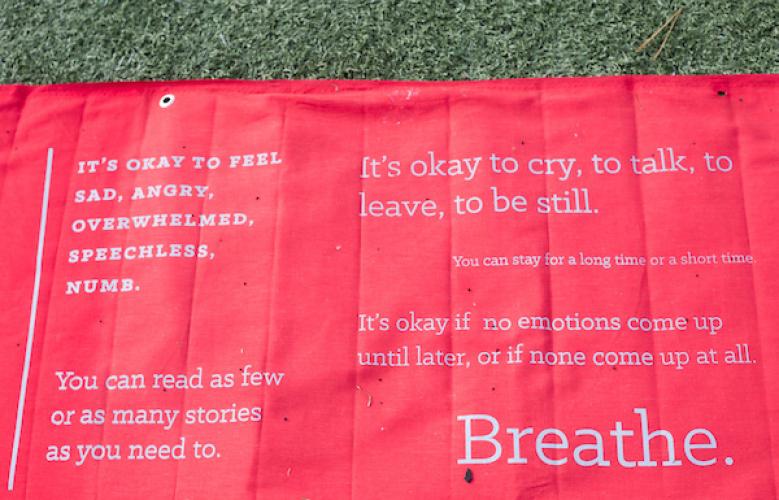
Fall arts-based survivor-centered exhibition to explore geographies of space

The Ohio University’s Women’s Center is partnering with the Survivor Advocacy Program, Health Promotion, Ohio University Art Galleries, Office of Instructional Innovation, Ohio Women, and Ohio University Alumni Association to host “In This Space: Disrupted,” an arts-based survivor-centered exhibition this fall.
The 2020 fall exhibition, which will focus on geographies of space, will make visible the places and spaces in which sexual assault, domestic violence, dating violence, stalking, and harassment occur and demonstrate how society can create spaces of healing.
It also hopes to make visible the often-anonymous public and private spaces in which interpersonal violence occurs and allow survivors to reclaim and occupy those spaces.
“By creating this visibility, we hope it instills awareness in viewers and is a call to action that challenges static narratives that the media often portrays as representing interpersonal violence and survivors,” said Dr. M. Geneva Murray, director of the OHIO Women’s Center. “We felt called to action on this theme because we frequently hear popular narratives that indicate that sexual violence happens only in particular spaces, perpetrated by particular people.”
Kim Castor, director of OHIO’s Survivor Advocacy Program, said one survivor recently described this process as, “Really on the dot for catharses and healing.”
“Many survivors find power in sharing their story but do not wish to do so in a public manner,” Castor said. “Exhibits such as this provide the opportunity for them to share in an anonymous manner.”
Survivors are asked to focus their contribution on one of these five prompts:
- In this Space: Without specifically naming the location, where did your experience of interpersonal violence occur? What physical space were you in? How may that have differed from where you believed these acts occurred? What feelings do you associate with that space now?
- Healing Space: Following your experience of interpersonal violence, how did you create space to heal? What did your process of healing look like? What spaces helped you heal? What spaces exist for you as safe? What feelings do you associate with healing spaces?
- Claim Space: If you have, or could, claim space as your own (physical/geographic, your own bodily autonomy, protest movements, etc.), what space would you make for you, your experience, and your survival? How would you change the spaces that are said to be created for you?
- Dangerous Space: What spaces have been retraumatizing?
- Safe Space: How does the public’s idea of dangerous (alleyways, bars, fraternity parties) and safe (home, in groups) space for survivors align with your experiences? What is different? What is similar?
“Additionally, we are excited to be expanding participation in this year’s exhibit to co-survivors. They play a vital role in the lives of survivors and we know that the trauma and impact of interpersonal violence isn’t just experienced by the survivor, but also by their friends, family, and loved ones.” Castor said.
Co-survivors of interpersonal violence (defined as those who are key support for the primary survivor, e.g. friends, family, partners) who want to participate should partner with a survivor, and only share experiences with the survivors’ consent and input, with the following prompts in mind:
Hold Space: How do you dedicate yourself to holding space for survivors?
Disrupt Space: How do you disrupt unsafe spaces in support of survivors? How do you define unsafe spaces? How are you an effective bystander in unsafe spaces?
In relation to the chosen prompt, organizers will provide participants with a fabric panel, and a fabric marker, that they encourage survivors to get creative with by marking the panel with a drawing of the space/place, a word cloud, a poem, manipulation of the fabric panel up to the parameters provided in the instructions (ripping, tearing, dirtying, etc.), iron-on transfers, applique, embroidery or painting.
Because participation is capped, please email survivor.advocacy@ohio.edu with your mailing address by June 3 if you wish to participate. Contributions should be returned to the Survivor Advocacy Program by mail no later than July 13.
This program has received an exemption from mandated reporting in order to allow for full-campus participation by all members of the campus community. Disclosures of incidents of sexual misconduct will not be considered notice to Ohio University.
If you have questions that relate to your experience and how that may be shared through the prompts, contact Survivor Advocacy Program at survivor.advocacy@ohio.edu. Please direct general questions about the exhibit, prompts, and/or display to the Women’s Center at womenscenter@ohio.edu.
Please review the details about the exhibition, guidelines for contributions, resources, and more before deciding to contribute by visiting https://www.ohio.edu/diversity/womens-center/space-disrupted
